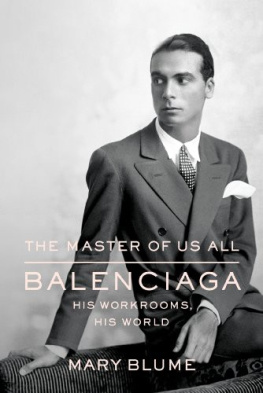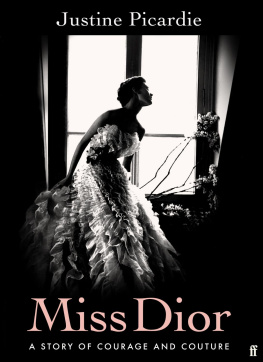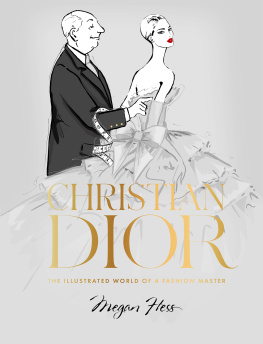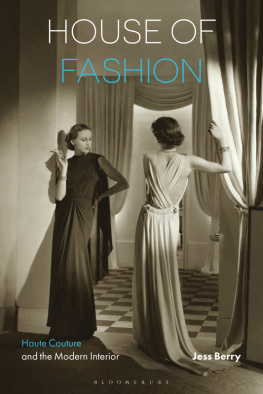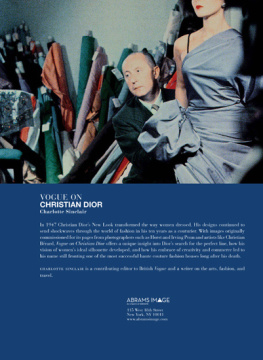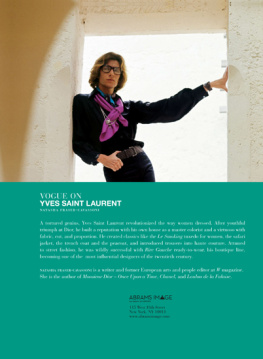A NOTE ABOUT THE AUTHOR
A native New Yorker, Mary Blume lives in Paris and was a longtime columnist for the International Herald Tribune . She is the author of Cte dAzur: Inventing the French Riviera and of a collection of Herald Tribune pieces, A French Affair .
ACKNOWLEDGMENTS
The most useful book on Balenciagas Spanish years is Cristbal Balenciaga: The Making of a Master (18951936) by Miren Arzalluz (2011) and, for the Paris years, Pamela Golbins Balenciaga Paris (2006). Also helpful is the first major study, Balenciaga by Marie-Andre Jouve and Jacqueline Demornex (1989), as are Balenciaga by Lesley Ellis Miller (2007) and Balenciaga: Spanish Master by Hamish Bowles (2010). For a memoir of Paris fashion from the 1930s to the 1950s, Bettina Ballards In My Fashion (1960) is excellent. Part of my material appeared, in different form, in the April 2007 issue of Vogue .
My agent, Bill Clegg, put me in the skilled and friendly hands of Farrar, Straus and Giroux, so my thanks go to him and to Jonathan Galassi, Courtney Hodell, Mark Krotov, Charlotte Strick, Jonathan Lippincott, and Jeff Seroy.
I am also deeply grateful to Samuel Abt, Miren Arzalluz, Rosamond Bernier, Luc Bouchage, Peter Brook, Elizabeth Coll, Anita Delion, Sonsoles Dez de Rivera, John B. Fairchild, Lucien Frydlender, Benot Gaubert, Hubert de Givenchy, Pamela Golbin, Robert Gottlieb, Immaculada de Habsburgo, Ian Hassett, Jean-Claude Janet, Janet Johnson, Marie-Andre Jouve, Brigitte Lacombe, Agustn Medina Balenciaga, Polly Mellen, Suzy Menkes, Lesley Ellis Miller, Aberri Olaskoaga, Richard Overstreet, Nicole Parent, Natasha Parry, Irving Penn, Caroline Pinon, Oscar de la Renta, Baronne Alain de Rothschild, Penelope Rowlands, Richard Sieburth, Danielle Slavik, Jean Stein, Susan Train, Florence Van der Kemp, Claudia Verbaum, and Gore Vidal.
And special thanks to Gal Mamine and the Balenciaga Archives Paris for their patience and generosity.
ALSO BY MARY BLUME
Cte dAzur: Inventing the French Riviera
A French Affair: The Paris Beat, 19651998
Cristbal Balenciaga: a beautiful name. Elle magazine rhapsodized in 1950 that the four syllables of Balenciaga simply burst forth upon the page (actually, there are five), while a contemporary poet sees in the names swaying melody the flowing quality of Balenciagas clothes and exquisite justesse of their proportions. It is a once-upon-a-time sort of name that should be part of a fable, and it is.
The setting is the humble fishing village of Getaria on Spains Basque coast, between San Sebastin and Bilbao, the date early in the last century. The fairy tale has many versions, but let Pauline de Rothschild, the former Pauline Potter, begin:
In the center of a street made dark by the shadows of its thick stone houses, a woman was walking, her back turned to the light from the sea. She wore a pale, ankle length, silk shantung suit. The severe houses enclosed her, shuttered.
A boy was watching her.
She would come almost abreast of him, and he would run up a side-street of the fishing village, so closely carved into the mountain that its streets are as steep and narrow as Genoas, some entirely made of steps. Down another he would run and be ahead of her again.
Then he would stare.
One day he stopped her, and asked if he could make a suit for her. The boy was about thirteen, with dark hair and darker eyes and the smile he would keep all his life.
Why do you want to do this? she asked.
Because I think I can, he answered.
The boy was Cristbal Balenciaga
The woman was the old Marquesa de Casa Torres (or her daughter-in-law) and she was wearing a white (or beige) Worth, Drecoll, Ceruit, or Redfern dress or suit, according to who is telling the tale. She was possibly on her way to (or from) Mass. The boy may have been as young as six (or as old as nineteen), and his fatherwho had died of a heart attack or was drowned at seawas either a fisherman or the captain of the royal yacht. Cheeky young Cristbal, the legend continues, copied her outfit so perfectly that the marquesa became his patron and took him while he was still in his teens to meet the great couturier Jacques Doucet in Paris.
Some of this is true.
But much of it isnt. The very plainness of plain fact has never seemed to fit someone so exotic as Balenciaga (as if the amazing could not spring from the quotidian), and so for decades the legends were embellished rather than investigated. Then a young Basque curator named Miren Arzalluz took the trouble to dig into official records and in 2010 published her findings about Balenciagas family and early years. Myths, uncovered facts, and ones own instinct about the mix can finally make a coherent, if spare, whole.
Getaria, Balenciagas birthplace, is a modest and handsome fishing village whose past as a whaling port brought it sufficient wealth to have as its center an oversize Gothic church, San Salvador, of surpassing gloom and considerable weirdness because its near-trapezoidal floor tilts noticeably up toward the altar. A statue near the city hall honors the local hero, Sebastin de Elcano, the first captain to circumnavigate the globe (as Magellans second in command he took over when Magellan was killed in the Philippines), and new plaques mark the birthplaces of Balenciaga, in a tidy small house near the church, and the mother of Plcido Domingo, over an anchovy cannery. Getaria has excellent fish that restaurateurs grill in the street, and gray buildings whose sound proportions and straightness of line are bolder than the often-quaint Basque architecture of France. Even now Getaria has an air of provincial rectitude; its inhabitants provided San Sebastin, thirty kilometers along the coast, with fish and services when the Spanish king and his court went there each summer.
In about 1853, Frances Empress Eugnie, who was born in Spain, invented Biarritz as a fashionable resort. Following her example, in 1887, Queen Mara Cristina of Spain decided to make San Sebastin, across the border, the official summer home of the Spanish court. While Biarritz is dramatic and citified, San Sebastin is calmer and more elegant, with a wide seafront and restaurants that have made it a foodie mecca today. Friends in Paris were often surprised by the supposedly austere Balenciagas pleasure in good eating, but he was Basque, and three existential questions, it is said, trouble the Basques each day: Where do we come from? Who are we? What are we going to have for dinner?
The last question results in excellent local cooking; the first two are harder. No one knows where the Basques come fromeven the prevalent blood type differs from that of other Europeansand they like to think of themselves as Europes aborigines, their spiritual locus being an ancient oak tree in Guernica. The Basques language, Euskera, once believed to be the tongue spoken in the Garden of Eden, bears no relation to any other, and they group all the other languages in the world in one single dismissive word, Erdera. They are proud (by an ancient royal Spanish edict they are all aristocrats), deeply Catholic, and intractable. Cristbal Balenciaga was definitely Basque.
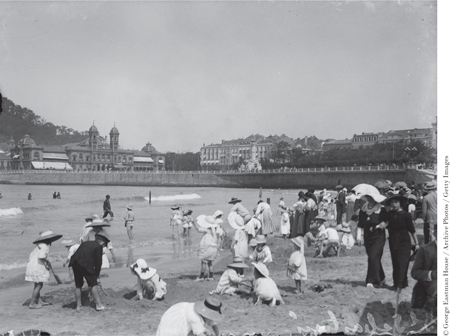
Beachgoers at San Sebastin, circa 1900
The family was modest but respected: his father, a fisherman, served briefly as mayor of Getaria and rose to skipper the launch that was often used by the Spanish court, including the queen, in the summer season. His mother bore five children, two of whom died in infancy. Cristbal, born in 1895, was the youngest; his sister, Agustina, and his brother, Juan Martn, remained his business associates in Spain throughout their lives. The older children were already at work when their father died after a stroke, leaving eleven-year-old Cristbal alone to help out his mother, Martina Eizaguirre.
Next page
